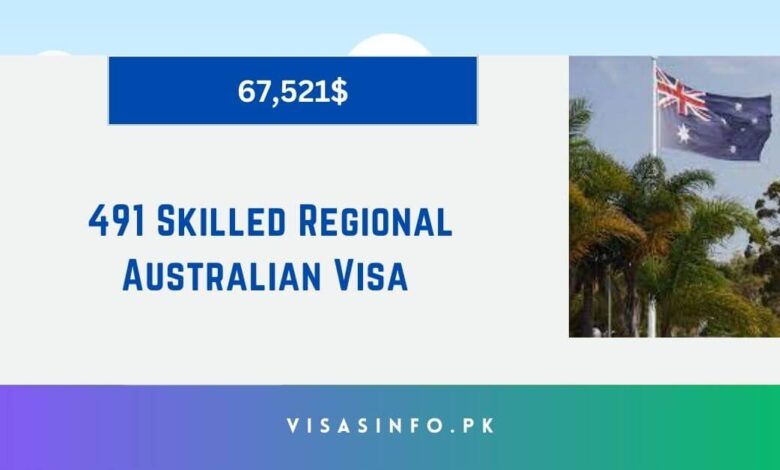491 Skilled Regional Australian Visa 2025 – Apply Now

This article delves into the specifics of the 491 Skilled Regional Australian visa and the most recent Australian immigration 491 program, which is referred to as AMP PR. To obtain all the pertinent information, please continue reading until the conclusion. Let us investigate the specifics of the class 491 skilled regional visa in Australia.
Regional Skilled Visa Class 491
The 491 Visa, which is frequently used to describe this visa, is designed to address the labor deficit in regional areas of Australia by enticing qualified professionals to relocate there. In this comprehensive guide, we will analyze the eligibility requirements, application process, point system, benefits, and significant factors associated with the class 491 Visa.
Whether you are contemplating immigration to Australia or simply wish to gain a deeper understanding of the Pathway to residency, this guide will provide valuable insights.
Comprehending the Class 491 Skilled Regional Visa
The class 491 Regional Visa program was implemented by the Australian government in order to encourage the migration of skilled workers to regional areas where labor is in high demand and to disperse individuals from the three largest cities in Australia, Sydney, Melbourne, and Brisbane. The government aims to enhance the economic development and expansion of these regional areas, thereby rendering them desirable destinations for both employment and residence.
Check Also: Australia 186 Visa Application Process for Direct PR
Criteria for Eligibility
The eligibility procedure for the class 491 skilled Regional Visa is contingent upon the fulfillment of numerous requirements by applicants.
- Occupational Category: Candidates must possess a position on the Department of Home Affairs’ inventory of skilled occupations. This list contains the professions that are in high demand in Australia.
- Age: Candidates must be under the age of 45 at the time of application.
- Skills Evaluation: Before applying for a visa, applicants must undergo a positive skills evaluation for the position they have chosen.
- English language proficiency: candidates must achieve a minimum level of fluency in the language, typically achieving a score of six on each segment of the International English Language Assessment.
- Language testing system (IELTS) examination.
- Points Exam: the 491 class Applicants must accumulate a minimum of 65 points under the points-based visa system, which is contingent upon a variety of factors, including age, education, work experience, and English proficiency.
- State nomination: In addition to obtaining a nomination from the government of a specific Australian state or territory, applicants must also register for a 491 Visa. The applicant must satisfy the specified requirements of the state in which they intend to establish their residence. The list of occupations and qualifications is unique to each state.
- It is imperative to emphasize that satisfying these eligibility criteria is merely the initial phase. The actual nomination and invitation process may be quite competitive, contingent upon the state you choose.
Point System and State Nomination
The point system is a critical element of the class 491 Visa. To qualify for this visa, candidates must accumulate a minimum of 65 points. These points are awarded based on the subsequent criteria:
- Age: Points are assigned on a declining scale, with individuals under the age of 25 receiving the most points and those over the age of 25 receiving fewer points as they age.
- Proficiency in the English language is a requirement for the use of the point system. Increasing your IELTS scores in all four categories—speaking, reading, writing, and listening—will result in a greater number of points.
- Employment Experience: The point value increases as the amount of experience in a relevant field increases.
- Education: a higher degree of education can also result in the acquisition of additional points.
- Spouse Skills: Points may be granted to the principal applicant’s spouse if they possess a specific specialized occupation and possess proficient English language skills.
State Nomination
State administrations may award candidates additional points for their commitment to residing and working in their designated state or territory. State nomination is a critical component of the application procedure. It allows local states and territories to identify immigrants who possess the necessary qualifications and skills to address labor shortages in their area. Candidates must become acquainted with the prerequisites of the state to which they intend to apply and modify their objectives and skill set accordingly.
Benefits of the Class 491 Skilled Regional Visa
- Pathway to Permanent Residency: The Subclass 191 Permanent Residence (Skilled Regional) Visa allows applicants to file for permanent residency after holding the visa for three years and satisfying the income and residency requirements.
- Australia Extended Stay Visa: This visa permits you to remain in Australia for a maximum of five years, providing you with the opportunity to establish a career and existence in a regional area.
- Work and Study Rights: In certain regional areas of Australia, it is permissible to reside, work, and pursue education. Sydney, Melbourne, and Brisbane are the only cities in Australia that are not considered regional locations.
- Increased Points for Skilled Migration: The Subclass 491 visa offers an additional 15 points toward the points-based immigration system, thereby increasing the likelihood of meeting the points threshold for skilled migration.
- Access to Healthcare and Education: Visa holders are permitted to enroll in courses that are pertinent to regional development, as well as to access Australia’s public healthcare system (Medicare).
- Family Inclusion: You have the option to include family members (partner and dependent children) in your visa application, which will enable them to join you in Australia and access the same work, study, and health benefits in the same manner.
- Enhanced Employment Opportunities: Regional areas frequently experience a shortage of skilled labor in industries such as healthcare, education, construction, and engineering, which generates a wide range of employment opportunities.
- Regional Government Support: Subclass 491 visa holders are provided with supplementary resources and support by numerous regional governments, such as community integration services and employment assistance.
- Ability to Move Within Regional Areas: The ability to relocate between designated regional areas allows for the selection of a location to reside and pursue employment.
Application Process and Timelines
The application procedure for the class 491 skilled Regional Visa involves a variety of essential steps.
- Skills Evaluation: Before applying, candidates must obtain a positive skills evaluation from the relevant authority for the occupation they have chosen.
- Applicants must satisfy the minimum requirements for English language proficiency.
- Accumulate the essential documentation: Obtain any necessary documentation, including job records, educational certifications, and identification documents.
- Applicants are required to select a site to submit an Expression of Interest (EOI) by utilizing the Department of Home Affairs talent. Include information regarding your qualifications and other relevant attributes in this section.
- State nomination: You will be required to apply for nomination under the state or territory in which you plan to establish your residence. Each region or jurisdiction has its nomination process and criteria.
- Invitation: Upon being nominated, you are required to apply for a class 491 visa. In general, you are granted sixty days to submit your application.
- To apply for a visa, complete the application, submit the required documentation, and make the required payments.
Processing Time
The processing time for class 491 The type of visa you receive may vary depending on the state or territory in which you submit your application and your unique circumstances. Typically, the entire process, from the submission of the EOI to the granting of the visa, can take between one and two years to complete.
The class 491 qualified Regional Visa is available to individuals who are skilled and wish to reside and work in Australia’s regional areas. It is a desirable alternative for immigrants due to the advantages it offers, such as the possibility of permanent residency and the flexibility to choose their employment, despite the fact that it requires the fulfillment of specific qualifying requirements and the accumulation of sufficient points.
This exhaustive investigation provides a comprehensive analysis of the class 491 visa. Consequently, this encompasses the entire spectrum, from the eligibility criteria and point system to the application process and benefits. If you are contemplating applying for this type of visa, conducting research and consulting with immigration specialists will assist you in navigating the intricate application process and realizing your aspiration to reside in Australia.
Frequently Asked Questions:
-
Who is eligible for a 491 visa in Australia?
A state or territory government agency must nominate you to apply, or an eligible relative must sponsor you. Your occupation must be listed on a relevant skilled occupation list. Ensure that the occupation has a suitable skills assessment.
-
Is education free in Australia for a 491 visa?
485, 491, and 494 visa holders pay 50% of the tuition fees listed above. Upon application, evidence of a visa will be required to confirm your tuition fee rate. A non-refundable application fee of AU $150* per student will be charged for all new applications.
-
Can a person with a 491 visa buy a house in Australia?
Australia as a temporary resident. You can successfully navigate the process by understanding the legal requirements, obtaining FIRB approval, and seeking professional advice.



